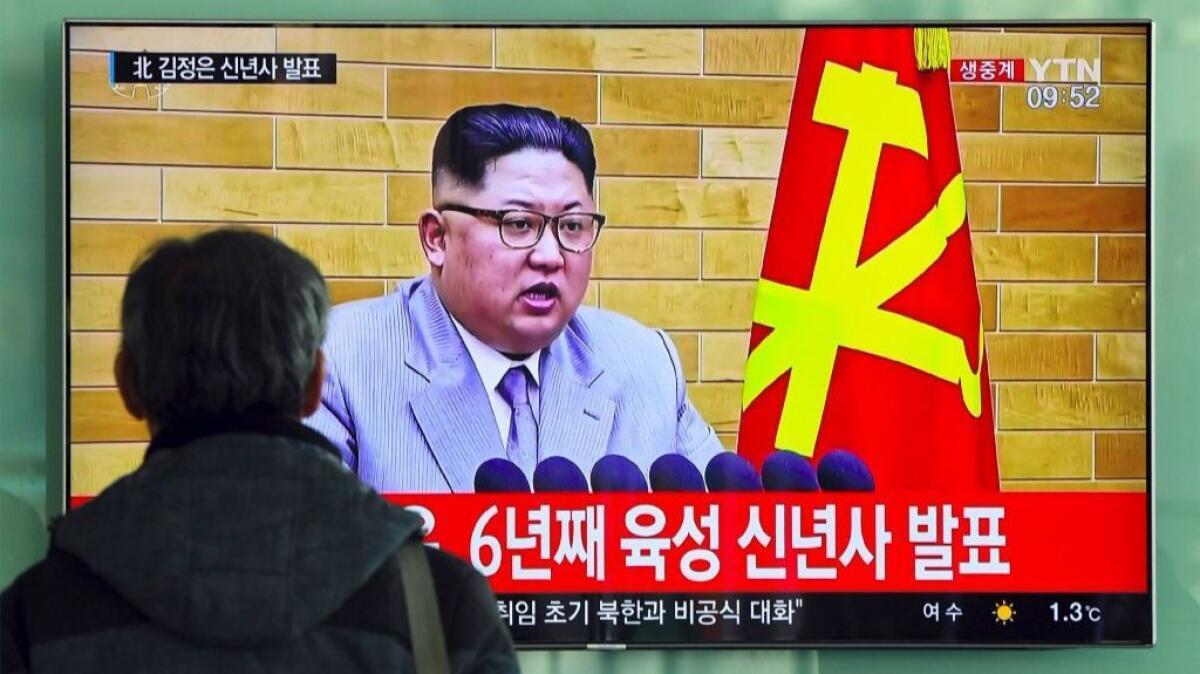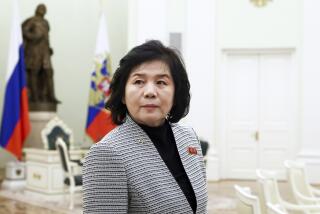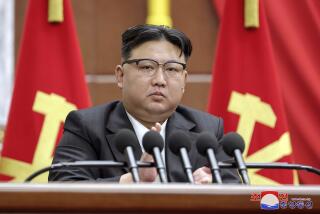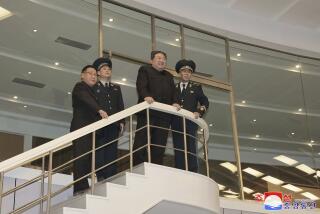Trump says his ‘Nuclear Button’ is bigger and more powerful than North Korea’s, and ‘my Button works!’

The White House offered a mixed reaction Tuesday to an apparent diplomatic overture from North Korean leader Kim Jong Un to neighboring South Korea, and to Seoul’s proposal to begin talks directly with Pyongyang next week, a move that could sideline the United States in the volatile region.
After staying mum for two days about Kim’s offer, President Trump issued a tweet early Tuesday that repeated his favorite insult for the North Korean ruler, and then seemed to take partial credit for any thaw on the Korean peninsula while staying ambivalent about possible outcomes.
“Rocket man now wants to talk to South Korea for first time. Perhaps that is good news, perhaps not — we will see!” Trump wrote.
But on Tuesday night, Trump added a truculent nuclear taunt in response to Kim’s claim that the United States is “within the range of our nuclear strike and a nuclear button is always on the desk of my office.”
Moments after Fox News highlighted the quote, Trump tweeted: “Will someone from his depleted and food starved regime please inform him that I too have a Nuclear Button, but it is a much bigger & more powerful one than his, and my Button works!”
If Washington was wary, Seoul appeared eager to accept Kim’s offer, which was part of a New Year’s speech that is closely analyzed each year for clues to the enigmatic leader’s thinking. The two longtime adversaries have not held direct talks for more than two years.
Cho Myoung-gyon, South Korea’s minister for unification, proposed Tuesday that negotiators meet on Jan. 9 at the divided border village of Panmunjom to discuss cooperation at next month’s Winter Olympics in Pyeongchang, South Korea, and how to improve overall ties.
So far, no North Korean athlete has qualified for the Games, which start on Feb. 9. But South Korean officials have said they are working with the International Olympic Committee to grant wild cards to North Korean athletes in a sign of inter-Korean reconciliation.
The Jan. 9 talks, should they take place, notably would not include the United States, China, Japan or Russia, which have dealt with North Korea in unsuccessful multi-party negotiations in the past. Nor would they include U.S. demands that Pyongyang give up its growing nuclear arsenal, and stop testing long-range ballistic missiles.
That raised red flags for U.S. officials who questioned Kim’s motives, his sincerity and South Korea’s ability to deal with the wily ruler.
“We won’t take any talks with North Korea seriously if they don’t do something to ban their nuclear weapons,” Nikki Haley, the U.S. ambassador to the United Nations, said at the U.N. on Tuesday. She said Pyongyang was a “reckless regime” that could not be counted on to enter talks in good faith.
“We don’t need a Band-Aid,” she said. “We don’t need to stop and take a picture.”
The State Department was less openly critical even as it urged caution.
“We are close allies, and if [South Korea] wants to sit down and have a conversation with North Korea, that’s fine, that’s their right,” State Department spokeswoman Heather Nauert said. “But we aren’t necessarily going to believe that Kim Jong Un is sincere.”
White House Press Secretary Sarah Huckabee Sanders insisted that the U.S. alliance with South Korea is “stronger than it ever has been,” with both countries working toward a denuclearized Korean peninsula.
U.S. strategy continues to be “maximum pressure” to convince Pyongyang to end its nuclear program, she said. “We are going to keep all of our options on the table.”
Chinese Foreign Ministry spokesman Geng Shuang, at a regular news briefing on Tuesday, said China “welcomes and supports” an opportunity for the two Koreas to improve relations, ease tensions and denuclearize the peninsula. “This is a good thing,” he said.
Some analysts suggested that Kim was attempting to exploit recent divisions between Washington and Seoul. Relations between the long-standing allies have been strained under Trump, who has openly clashed with South Korean President Moon Jae-in.
Trump, who visited Seoul in November, has repeatedly threatened to scrap a bilateral free trade deal with South Korea, and last summer condemned what he called Seoul’s “talk of appeasement” with the North. “Talks are not the answer!” he tweeted on Aug. 30.
Moon, in turn, appeared to rebuke Trump’s threat to unleash “fire and fury” against North Korea, saying any military actions on the Korean peninsula required consultation and agreement from Seoul. He has publicly suggested military talks with the North in an effort to ease the growing impasse.
On Tuesday, Moon appeared to align with the U.S. view about the long-term goal of any negotiations, suggesting talks with Pyongyang this month might be a first step.
“The improvement of relations between North and South Korea cannot go separately [from] resolving North Korea’s nuclear program,” Moon said ahead of a Cabinet meeting.
Kim may feel he can offer talks from a position of strength. In September, his government tested its sixth and most powerful nuclear device. In November it tested a long-range ballistic missile that U.S. officials said could potentially reach anywhere in America.
In his New Year’s speech, Kim declared his nation had achieved the “historic feat of completing” its nuclear force and that the entire United States was now within range. He also warned that the “nuclear button” was on his desk, although it appears more symbolic than strategic.
North Korea still has not developed a nuclear weapon that can survive a missile launch and reentry, though U.S. officials say that’s probably a matter of time. And the country still uses liquid-fueled ballistic missiles that take hours or days to launch.
In his speech, Kim appeared conciliatory toward South Korea, saying the two countries “should lower the military tensions on the Korean peninsula to create a peaceful environment.”
Rather than showing strength, Kim may be showing his skill at making the best of a weak hand, said Sue Mi Terry, a former CIA analyst who now holds the Korea Chair at the Center for Strategic and International Studies, a nonpartisan Washington think tank.
“With his outreach offer, he has the potential to drive a wedge between Washington and Seoul at no cost to himself,” she said, adding he might even demand concessions in return for participation in the Olympics.
It would be a “propaganda gold medal for Kim,” Terry said. But if the Moon administration makes unilateral concessions to the North, she added, “it significantly risks straining the alliance” with the Trump administration.
Over the last year, the United Nations Security Council and the Trump administration have both imposed trade sanctions on North Korea, curtailing its ability to buy oil and gas, sell agricultural products, use overseas workers to raise foreign capital, or conduct other business in international markets.
Ian Bremmer, president of the Eurasia Group, a risk analysis consultancy, said Tuesday that the chances of a significant breakthrough, forged on the back of the Olympic Games, have elevated. But the unknown and potential spoiler is Trump’s reaction.
Trump could launch an “enormously dangerous” Twitter firestorm, Bremmer said, or “take a 180-degree turn,” take credit for any progress, as his tweet Tuesday seemed to do, and then revive talk of a possible deal with Pyongyang that only he could cut.
“We are at a bigger chance than during any time in the Obama administration for dialogue,” Bremmer said. “And we are at a bigger chance for war.”
For more on international affairs, follow @TracyKWilkinson on Twitter
UPDATES:
7:38 a.m.: This article was updated with a new headline.
5:55 p.m.: This article was updated with a tweet from President Trump.
4:45 p.m.: This article was updated with reaction from China.
This article was originally published at 4 p.m.
More to Read
Start your day right
Sign up for Essential California for news, features and recommendations from the L.A. Times and beyond in your inbox six days a week.
You may occasionally receive promotional content from the Los Angeles Times.







